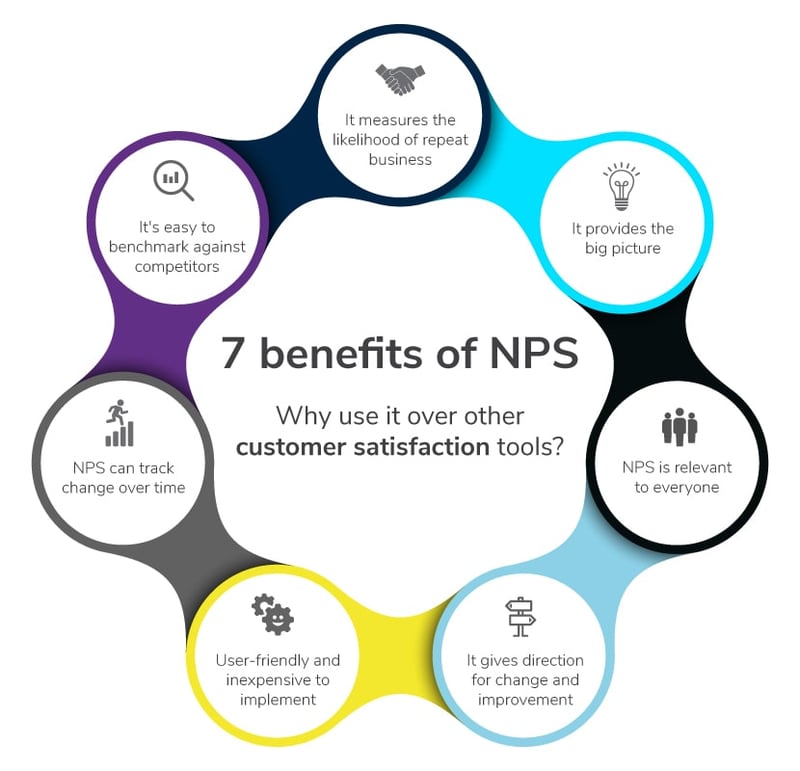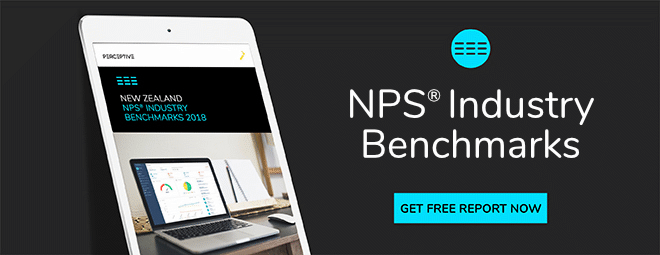The Net Promoter Score system is one of the most popular customer experience tools available today. It seeks to measure customer satisfaction as well as loyalty, using a single, simple score between -100 and +100 to translate a myriad of confusing metrics into a single measure of customer experience success.
But that's just the start of why many choose Net Promoter Score (NPS) over these other measures.

1. It measures the likelihood of repeat business
All customer satisfaction tools are designed to give businesses an insight into what customers think about them. There are few out there, with the most common being Customer Satisfaction (CSAT), Customer Effort Score (CES) and NPS. However, it’s the type of insight that businesses want which determines the best tool to use.
If you want to measure customer loyalty, NPS is ideal. But if you want to gauge satisfaction towards a particular product or service-interaction, a CSAT might be a better fit. Want to understand how much effort customers had to put in to get their needs met? CES is the tool for you.
One of the key benefits of Net Promoter Score is that it measures the likelihood of new and repeat business. This measure is useful for forecasting business growth, cash-flow, as well as assess the health of your brand and overall customer satisfaction.
Related content: 10 ways a customer survey drives your business growth
2. It provides the big picture
Since CSAT and CES surveys are sent when customers buy or use a product or service, they are, by their nature, only relevant to the customer’s last interaction with a business. That is, they only capture short-term customer satisfaction data, after say a service ticket, and not the customer’s overall relationship with your business.
An unhelpful service call could result in a poor CSAT or CES result when a customer evaluates that single interaction. Nonetheless, they might still like the product(s) and the company at large. This is what NPS reveals: customer sentiment towards your business as a whole unit—your product, your service, your website, social presence, front-of-line staff, everything.
Learn more: Dial up your NPS and your business with our free guide Grow your business with NPS
3. It’s relevant to everyone
NPS’s -100 to +100 scoring system is simple to understand, which making easy for busy business executives to digest and fellow office staff to get their heads around it. And because NPS is a measure of your whole business, it’s a KPI that is relevant to everyone—not just to your executive team or service call centre.
A strong NPS reflects that your business is doing everything right—from the initial front-line staff to the product/service, marketing, and customer support. Every link in the chain is performing well. Likewise, a low score could indicate that there are a few kinks that need ironing out—which is why it’s vital to ask follow-up questions (more on this in a moment).
Research also shows that excellent customer service is more likely to happen when employees are engaged and passionate about their work. Therefore, from a human resources perspective, a strong NPS also provides some insight into staff satisfaction as well.
Related content: 3 secrets to a successful employee engagement survey
4. It gives direction for change and improvement
People often wrongly think NPS is just one question, but that’s not quite true. To uncover the real potential of NPS, you need to ask follow-up questions. These questions are essential to understanding why customers do (or don’t) recommend you.
Without their feedback, your NPS score is just a number. Worse still, you have no way to know what you need to change to improve your NPS score. Change for the sake of change is ineffective—and frustrating for your staff. Asking follow-up questions, however, gives direction to what that change needs to be.
Related content: 3 big customer feedback strategy fails
5. It’s simple, user-friendly and inexpensive to implement
From a customer perspective, NPS surveys are quick, straightforward and can be done online, by email or over the phone. There’s one main question: “How likely are you to recommend this business to a friend?”, often followed by one or two supplementary questions to encourage further feedback. All up, the survey rarely takes more than five minutes to complete.
On the business side, NPS breaks down your scores into three customer clusters: detractors, passives and promoters. A simple calculation (percentage of promoters minus percentage of detractors) determines your score. There’s no advanced formulas or analytics involved.
6. It’s a great way to track change over time
As a rule, we recommend surveying your customers at least twice a year. Aside from getting the latest on your customer sentiment, regular survey data is ideal for identifying trends and tracking business performance over time.
Depending on how frequently you survey your customers, you can also to split the data to see month-on-month to year-on-year tracking. You may uncover seasonal trends, or see how any recent changes (be it staff or feedback-related changes) have affected customer experience.
You can also compare how different teams and departments are tracking both next to one another and on a wider industry (and global) level. Which brings us to the next point:
Related content: 3 ways to raise your survey response rates
7. It is easier to benchmark against competitors
NPS is a globally recognised system, which makes it easier for you to benchmark against competitors and track your progress compared to the rest of your industry. Finding benchmarks within your local geographic region is also a simple matter.
Read more: Satisfy and retain your customers with our free customer retention strategies guide.
In comparison, while CES is an effective tool to measure how much effort a customer has to go through to have their needs met, it doesn’t have the same uptake as NPS, and therefore benchmark data is difficult to come by. This is especially true if you want to see how you fare against competitors, or dive into industry-specific benchmarks, or investigate the regional benchmarks of smaller countries such as New Zealand.
Last of all, because CSAT is a) limited to the last interactions customers have with a business and b) has a so many variables in terms of what it can evaluate—a product/service, customer support, or online experience for example—it’s near impossible to establish industry and country benchmarks. The only benchmarks you can set are internal ones, based on your own data.
Learn how you compare to the rest of your industry with the latest Industry NPS Benchmarks for Australia and New Zealand.

